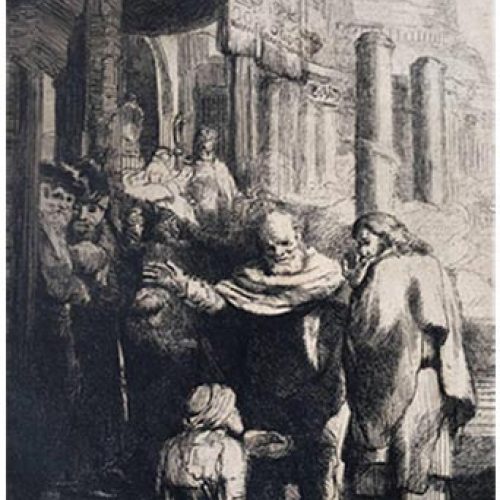On the remote chance of finding help for our young church, 25 years ago, I reached out to a Christian philanthropist & world-class classical guitarist. He invited me to meet with him at a private concert he was holding in the home of CRU (then called Campus Crusade for Christ) founder Bill Bright, a towering figure in 20th-century evangelicalism, likely 2nd only to Billy Graham in evangelical influence. CRU is the global organization responsible not only for numerous university ministries, but for the world’s most-viewed movie, “The Jesus Film,” & the evangelistic tool, “The Four Spiritual Laws.”
The musician is also a collector of fine art by renowned artists. He would display these pieces whether he played for royalty, heads of state, or school children. So when he agreed to come perform at our small church meeting in an elementary school, he also brought his art to display, & kept it overnight in our house, necessitating a special insurance policy back then worth $1 million. So, yes, I’ve had in my home a Rembrandt etching (as pictured), a Picasso painting, & a Faberge teaspoon (as well as rare historical documents), worth way more than the house!
Before the concert, I got to tour CRU’s headquarters on a 200-acre campus in Orlando. Works of fine art had been donated, so the plan was to develop guidelines for what works of art they would receive into the collection. For reasons I still don’t understand, the musician asked me to come up with those guidelines, though I have no background in the field other than majoring in art in high school! When I was a child, my ambition was to become an artist, so I was honored to do as asked. Here’s most of what I wrote back then:
“The purpose of the Campus Crusade for Christ Fine Arts Collection is to make available works of fine art for viewing, studying, & appreciating so as to lift the thoughts of man to God, & to illuminate the nature of man.
“Artistry is a gift of God. While God created ‘ex nihilo,’ we who are made in His image take the details of creation & arrange them in new & interesting ways. God proclaimed His creation ‘good.’ God is the author of beauty, & art helps humankind recognize that beauty, & develop the ability to simply enjoy the goodness of what has been created.
“God gave artistic talents to sculptors, silversmiths, & artisans of many sorts (Ex. 25:9-20, 31:1-11, 1 Kings 7:13-22). Art is a human reflection of the creativity & imagination of God Himself. Ideally, art should point human thought & appreciation to God. Art in its highest form is inspirational, & can enable man to gain deeper insight into the human condition. It can evoke emotions that a person could not existentially experience, communicating on levels that words cannot. It thus transcends barriers of time, space, & diversity, functioning as a unifying universal medium of language.
“While art has historically been used in religious & non-religious ways, it has always been a source of inspiration & spiritual stimulation, bringing hope, direction & meaning to life. Categories of ‘sacred’ & ‘secular’ can be misleading, for a work of art cannot rightly be called ‘holy’ only if it spells out a biblical message. Although Christian artists may seek to promote faith through their creations, art is not holy simply by virtue of its subject matter.
“Art that is explicitly Christian will celebrate the deity & glory of God in Christ, & it will celebrate what it means to be human. What makes art distinctively Christian is its redemptive quality. Christ came to redeem the cosmos, reversing the disorder of the created realm as a consequence of sin. Christian art will contribute, to some extent, to this ‘beautification’ process. Such art does not necessarily have to be created by Christians. Any expression of art that brings into focus the beauty of God’s creation is valid in a Christian context. As men participate in the redemptive (or beautification) process of the created order by creating beautiful things, they are mirroring God Himself.
“The Bible declares an aesthetic standard for what we should consider worthy of appreciation & study—whatever is true, noble, right, pure, lovely, admirable, excellent, or praiseworthy (Phil. 4:8). However, since art can be simply a vehicle for any kind of human expression, human depravity can also be depicted in such works. Often, the products of such creativity are not acceptable in a Christian context. It is valid to express & study the depravity of man, but the point at which one oversteps proper bounds is when sin is celebrated or made to appear attractive.
“To be received in the Campus Crusade for Christ Fine Art Collection: (1) Art pieces need not depict specifically Christian themes or biblical ideas, but should express an inspirational or historical quality that can be appreciated; (2) A work of art must not conflict with biblical standards of morality & modesty; (3) No depictions of nudity, sexual acts, vulgarity or gratuitous violence will be accepted. No depictions that are offensive or denigrating to religious sensibilities will be accepted.”
Alas, I doubt that CRU adopted these guidelines because I never heard back from them. But while a global ministry didn’t have use for them, you might find them helpful when it comes to evaluating art, music, film, literature, & other creative mediums.


